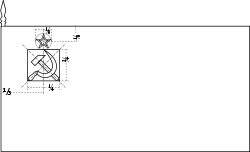Wladimir Nikolajewitsch Artjomow
Wladimir Nikolajewitsch Artjomow (russisch Владимир Николаевич Артёмов; * 7. Dezember 1964 in Wladimir) ist ein ehemaliger sowjetischer Kunstturner. Er gewann vier Goldmedaillen bei Olympischen Spielen und sechs Goldmedaillen bei Weltmeisterschaften.
Leben
Artjomow galt jahrelang als Spezialist am Barren, der im Zwölfkampf zwar Weltklasseübungen abliefern konnte, aber im Schatten seiner Mannschaftskameraden Juri Koroljow und Dmitri Bilosertschew stand, die von 1981 bis 1987 die Weltmeistertitel im Zwölfkampf gewannen. Bei den Olympischen Spielen 1988 löste er sich aus dieser Rolle und war mit vier Goldmedaillen der erfolgreichste Turner.
Wladimir Artjomow war der Nachfolger von Nikolai Andrianow, dem siebenfachen Olympiasieger im Kunstturnen, der ebenfalls aus der Turnschule von Wladimir stammt. 2006 wurde Wladimir Artjomow in die International Gymnastics Hall of Fame aufgenommen.
Erfolge
- Olympische Sommerspiele 1988 in Seoul
- Gold im Zwölfkampf
- Gold in der Mannschaftswertung
- Gold am Barren
- Gold am Reck
- Silber im Bodenturnen
- Turn-Weltmeisterschaften 1983 in Budapest
- Silber in der Mannschaftswertung
- Gold am Barren
- Turn-Weltmeisterschaften 1985 in Montreal
- Gold in der Mannschaftswertung
- Silber im Zwölfkampf
- Turn-Weltmeisterschaften 1987 in Rotterdam
- Gold am Barren
- Gold in der Mannschaftswertung
- Silber im Bodenturnen
- Bronze im Zwölfkampf
- Turn-Weltmeisterschaften 1989 in Stuttgart
- Gold am Barren
- Gold in der Mannschaftswertung
- Silber am Reck
- Silber im Bodenturnen
- Bronze im Pferdsprung
Literatur
- Volker Kluge: Olympische Sommerspiele. Die Chronik IV. Seoul 1988 – Atlanta 1996. Sportverlag Berlin, Berlin 2002, ISBN 3-328-00830-6.
Weblinks
- Wladimir Artjomow in der Datenbank der Fédération Internationale de Gymnastique (englisch)
- Wladimir Artjomow in der International Gymnastics Hall of Fame (englisch)
- Wladimir Artjomow in der Datenbank von Olympedia.org (englisch)
| Personendaten | |
|---|---|
| NAME | Artjomow, Wladimir Nikolajewitsch |
| ALTERNATIVNAMEN | Владимир Николаевич Артёмов |
| KURZBESCHREIBUNG | sowjetischer Kunstturner |
| GEBURTSDATUM | 7. Dezember 1964 |
| GEBURTSORT | Wladimir |
Auf dieser Seite verwendete Medien
Olympic Rings without "rims" (gaps between the rings), As used, eg. in the logos of the 2008 and 2016 Olympics. The colour scheme applied here was specified in 2023 guidelines.
US Flag with 45 stars. In use 4 July 1896–3 July 1908. Created by jacobolus using Adobe Illustrator, and released into the public domain. This flag was used during the Spanish-American War.
Autor/Urheber: F l a n k e r, Lizenz: CC BY-SA 2.5
Flagge des Königreich Italiens (1861-1946) In einem staatlichem oder militärischem Kontext ist die Version mit der Krone zu verwenden.
Autor/Urheber: F l a n k e r, Lizenz: CC BY-SA 2.5
Flagge des Königreich Italiens (1861-1946) In einem staatlichem oder militärischem Kontext ist die Version mit der Krone zu verwenden.
Die quadratische Nationalfahne der Schweiz, in transparentem rechteckigem (2:3) Feld.
National- und Handelsflagge des Deutschen Reiches von 1935 bis 1945, zugleich Gösch der Kriegsschiffe.
Das Hakenkreuz ist im Vergleich zur Parteiflagge der NSDAP um 1/20 zum Mast hin versetzt.
National- und Handelsflagge des Deutschen Reiches von 1933 bis 1935.
Flagge Finnlands
(c) I, Cmapm, CC BY-SA 3.0
The flag of the Soviet Union (1955-1991) using a darker shade of red.

(c) I, Cmapm, CC BY-SA 3.0
The flag of the Soviet Union (1955-1991) using a darker shade of red.

Variant version of a flag of Japan, used between January 27, 1870 and August 13, 1999 (aspect ratio 7:10).
Variant version of a flag of Japan, used between January 27, 1870 and August 13, 1999 (aspect ratio 7:10).
Olympische Flagge
Flag of the Germans(1866-1871)
Vexillum Ucrainae
US Flag with 48 stars. In use for 47 years from July 4, 1912, to July 3, 1959.
US Flag with 45 stars. In use 4 July 1896–3 July 1908. Created by jacobolus using Adobe Illustrator, and released into the public domain. This flag was used during the Spanish-American War.
Pan-Slavic flag. Emerged from 1848 Prague pan-Slavic conference, or interpretations of the resolutions of the conference. Drawn by Fibonacci.






















